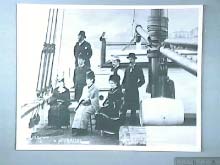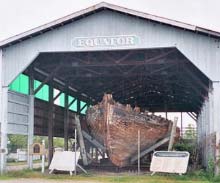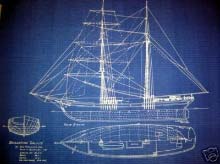In 1889 Robert Louis Stevenson was
world famous—not for Treasure Island—but
for Dr. Jekyll and Mr. Hyde. He was a sick man, visiting
the South Seas islands for his health. He originally came on the
95 foot fore-and-aft topsail schooner Casco,
named after the bay in Maine. Stevenson loved the Casco,
built by the Matthew Turner Shipyard. Now in Honolulu to pick
up his mail, he chartered another Turner schooner, the Equator,
for four months. At 100 feet and 75 tons, the Equator took him to Samoa.
 |
This is the Equator |
At right here is a picture of Stevenson on the far right, his
wife seated next to him with his mother on her right and family
friends. You can see Stevenson is a small man, thin, and at this
point in his life weakened by drugs taken for his constant illnesses.
This is the Equator. He bought a home in Samoa.
After trips to Australia and Honolulu, he came back to Samoa,
his wife and house where he died of pneumonia on December 3, 1893.
On the night of his funeral the two Samoan
chiefs stood guard and prayed all night. Then
in the morning 200 Samoans carried his body
as they hacked a path up the mountain of Samoa,
for Stevenson’s burial. His coffin was laid to rest on the
top of the mountain so the
birds might sing on his coffin undisturbed. No guns were allowed
on the mountain from that
day forward. The Samoans didn’t know he was world famous
for his books, they knew him
as their friend.
Robert Louis Stevenson was a thin, restless man with a boisterous
imagination, a mind often
allayed with drugs. Mrs. Stevenson had come from a conservative
back-bay Boston family.
She wore long Victorian dresses and fully-dressed hair no matter
how hot the climate.
Her class and gentility impressed the women of the island for
the rest of her life. With their
differences, still, Mr. and Mrs. Stevenson loved the life they
lived.
The Casco and the Equator were built by the Matthew Turner Shipyard. I had never heard of
Matthew Turner, but I discovered a fascinating man.
Turner came from Ohio, born in 1825. Lake Erie was full of shipping.
The lake stretched
from the Midwest to New York. Rivers came off of the lake, with
hundreds of coves and
inlets and tiny bays. In a newly settling country, trade through
the lake and the rivers was
brisk. The ships were built for cargo, not speed or leisure. They
had the hull of barges,
squared at the bottom with modest sail area. As a result young
Matthew saw huge ships.
A boy could watch the men build these huge ships, understanding
their simple building
methods taken to a huge scale. Railroads were approaching. Covered
wagons carried goods
out west, across an untouched land. To Matthew’s generation
the times seemed to beg for
empires, fortunes, big men with big ideas. Matthew Turner had
no fear of success.
His father taught him fishing and ship-building. In Ashtabula
County, Matthew could have seen the Salem Packet,
1818, a schooner at 27 tons. He could have seen the North
America, a steamer at 300 tons. He could have seen the Troy, 1840, at 130 tons. The steamers in the
1850s could range from 300-500 tons.
The yard employed 30 men who built 228 ships in 33 years. Every
ship was designed for speed. No slowpokes for Matthew Turner.
In 1901 the four masted Amaranth set a record
sailing 23 days from Shanghai to Astoria. The William
C. Irwin sailed from San Francisco to Kahalui, Maui,
in only 8 days. Turner had somehow made himself into a master
of ship design and shipbuilding. One wonders what innovations
he had in the yard to put out such huge ships, so often, without
wearying the men. On the east coast, Herreshoff had a type of
assembly line, with each man specializing in a certain task; possibly
Turner did the same thing.
These ships were huge, over 150 feet with some around 200 feet.
Turner probably thought the Casco and Equator were mere squirts by comparison. Here below is the Equator in Washington, undergoing restoration.
 |
Equator in Washington, undergoing restoration |
You can see the sharp forefoot. This was his
great innovation at a time when ships on the Pacific
coast were not built this way.
His second innovation was a triangular foreand-
aft sail on the mizzen mast. No one had
ever done this on the west coast before.
Turner’s most famous ship is probably the Galilee,
built in 1891. Galilee set a record of 22 days
from California to the South Seas island of Papeete, with its
average run being 28 days. In 1905 Galilee was
chosen to be the Carnegie Oceanic Magnetic Survey ship.
While all of this momentous activity was going on, Turner also
designed racing yachts for the
San Francisco Yacht Club where Turner was a charter member.
At the age of 81 Matthew Turner retired from his own yard, dying
three years later in 1909. The town of Benicia, California has
kept his name alive. An elementary school is named after him and
a plaque stands on the beach where the Turner Shipyard made history.
 |
Galilee |
By the way, when Joshua Slocum sailed across the Pacific, he
came to Samoa. He says he came to the island on July 16, after
some hard sailing into a stiff breeze. When he anchored, three
Samoans came out in a canoe, asking if he was alone. When Slocum
said he was, they thought he’d eaten another man to get
this far by himself.
The next morning Mrs. Stevenson came down to the dock to meet
Slocum. This is what
Slocum wrote:
I was of course thrilled when I found myself, after so many
days of adventure, face to face with this bright woman, so lately
the companion of the author who had delighted me on the voyage.
The kindly eyes that looked me through and through sparkled when
we compared notes of adventure. I marveled at some of her experiences
and escapes. She told me that, along with her husband, she had
voyaged in al manner of rickety craft among the islands of the
Pacific, reflectively adding, 'Our tastes were similar.'
 |
Matthew Turner Shipyard Site |
He married but his wife and child died in childbirth. That may
have driven him away from the lake, as in 1850 he yielded to California
gold fever. He rushed east toward New York to board a ship for
the Promised Land of Pacific gold. At the time the work in the
mines was back-breaking, but Matthew gained a small fortune. Still
he was not satisfied with life in the dark, chilling mines. He
took the gamble of traveling across the entire country, through
Indian territory on stagecoach and horseback, carrying the money
he’d exchanged for gold. Not the journey for a pencil pusher.
When he arrived at New York he bought a schooner, the Toronto.
This is just one of the times he showed the ability to be one
step ahead of the times in which he lived. The ports were full
of men with wild pasts and stuffed pockets, gambling on their
own future.
Stevenson describes Bristol in Treasure Island like
this:
..our way to my great delight lay along the quays and beside
the great
multitude of ships of all sizes and rigs and nations. In one,
sailors were
singing at their work, in another there were men aloft high over
my
head, hanging to threads that seemed no thicker than a spider’s...The
smell of tar and salt was something new. I saw the most wonderful
figureheads
that had all been far over the ocean. I saw many old sailors
with rings in their ears and whiskers curled in ringlets and tarry
pigtails
and their swaggering, clumsy sea-walk; and if I had seen as many
kings
or archbishops I could not have been more delighted.
So Matthew gambled on the skills his Dad taught him. He sailed
the Toronto back to California, where he joined
with another captain to bring lumber from Mendocino to San Francisco.
The business struck the new edge of the times, a new state, new
construction, a new optimism in California. Men thought settling
California was like settling the colonies all over. A new place
in which decent men could do things better than they’d been
done before. Turner thrived to the point that he could buy a larger
schooner, the Louis Perry. As the waterline lengthened,
profits grew.
And then four years later, he struck it rich. After purchasing
the brig Temandra, he sailed her up the coast
of Alaska where few men had ever sailed. He came across thousands
of codfish. There were so many, it seemed like all he had to was
yell and they’d flop on the deck. Codfish sold for a high
price in San Francisco.
Then he made a momentous decision. He had an insight to the
future again. He bought another
ship to do the fishing along the Alaskan coast while he sailed
for Tahiti. Now his life
turned. The desire to purchase a faster ship for the Tahiti trade
made him dissatisfied with
the ships he’d seen in San Francisco. So, being Turner,
he designed his own.
In 1868 Turner designed his first big ship, which he named Nautilus.
He had it built in a California yard. The Nautilus was big and fast, enriching the Tahiti trade immensely. At this
point he made another forward-thinking decision, to move his entire
operation to Benicia, California. He had his own yard, his own
ships, and in 1876 he married his partner’s widow. (Sam
Spade, another San Franciscan, wouldn’t have done that.)
All of this was accomplished with the boatbuilding techniques
of the day—which means by
hand and by eye. Just consider the opportunity to screw 10,000
screws by hand. Lumber
had to come from far away, and then there was finding Tahiti with
a sextant in leaping seas.

|

